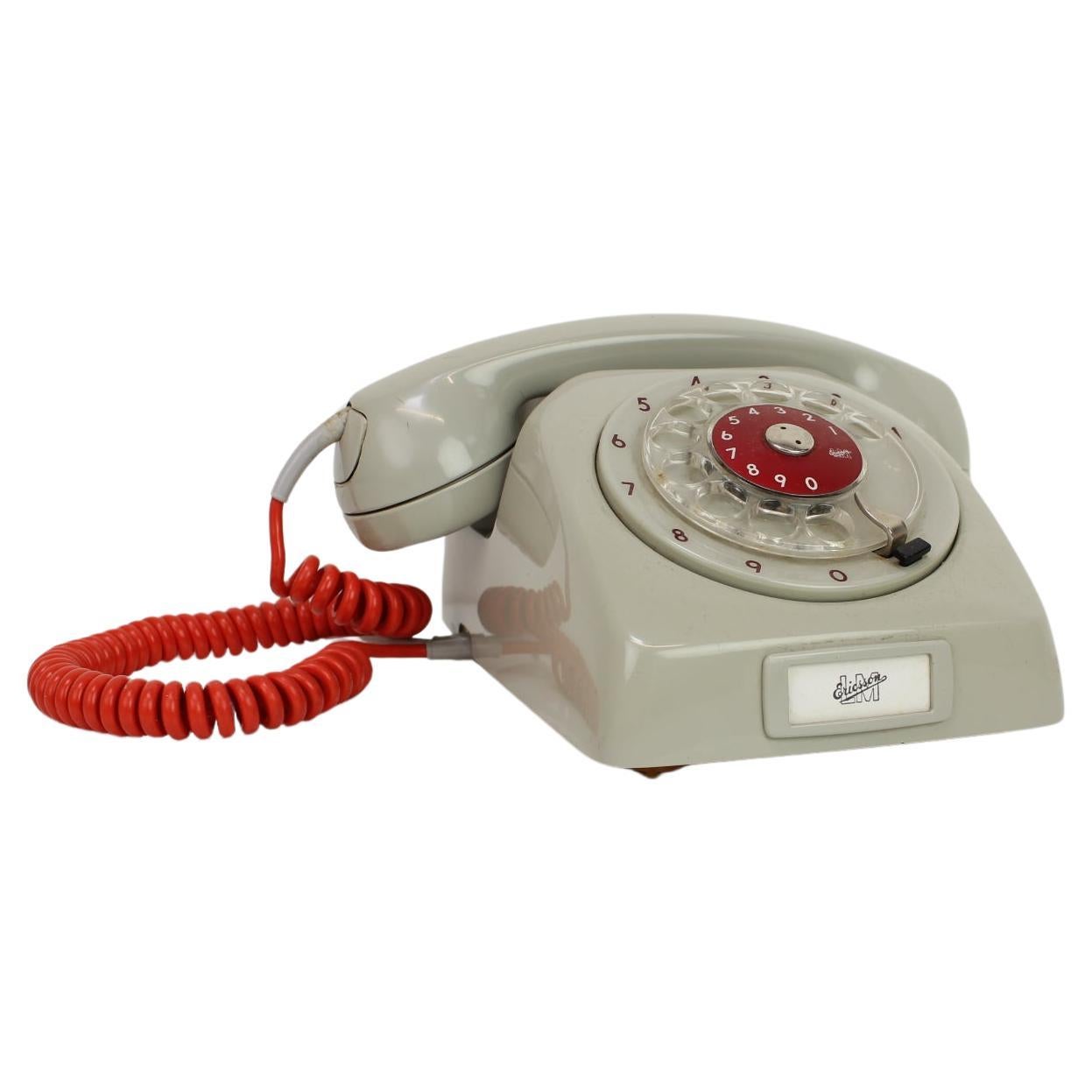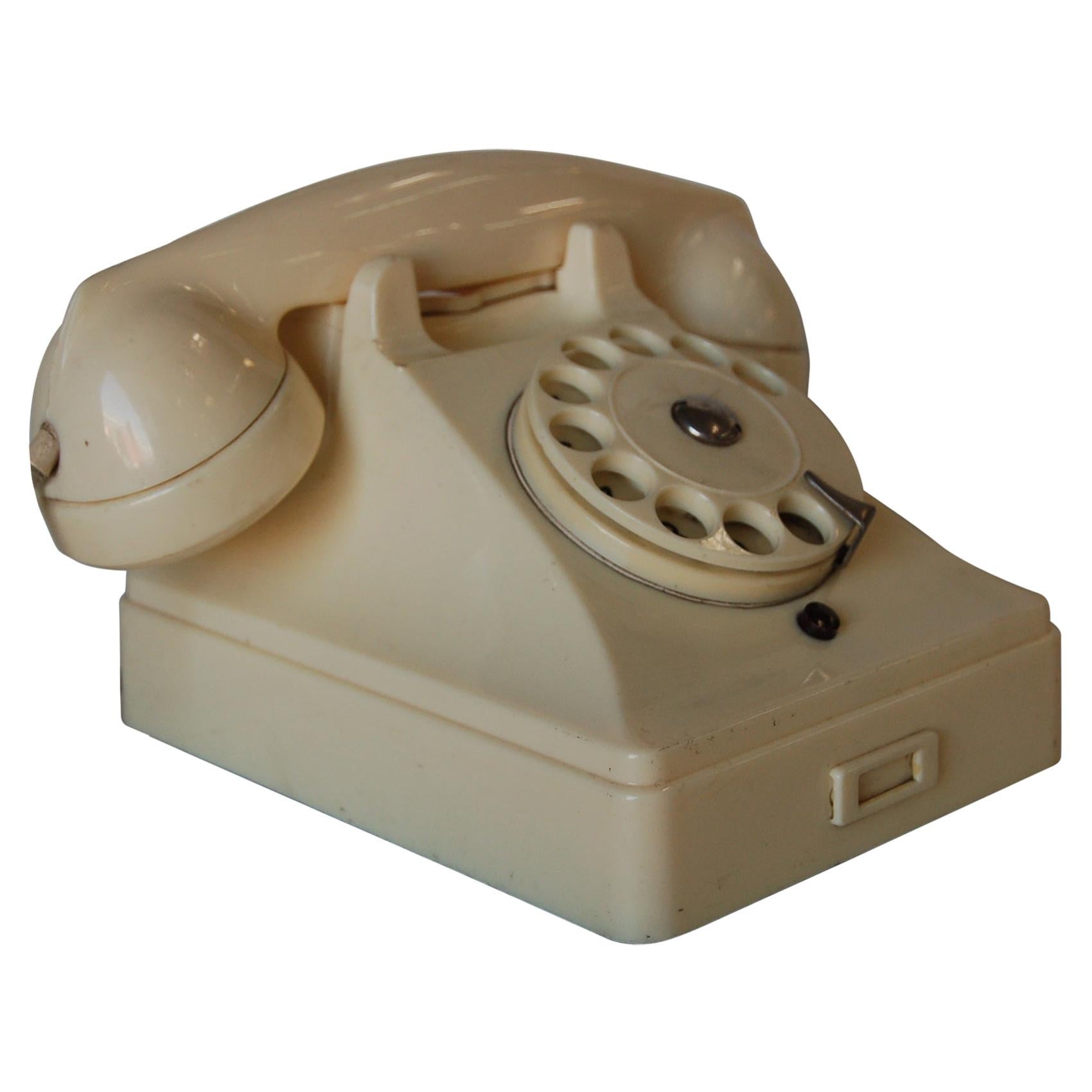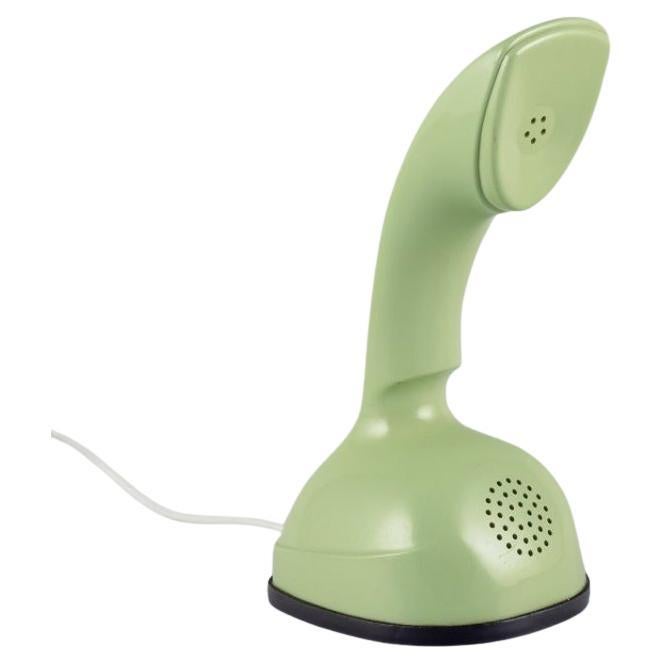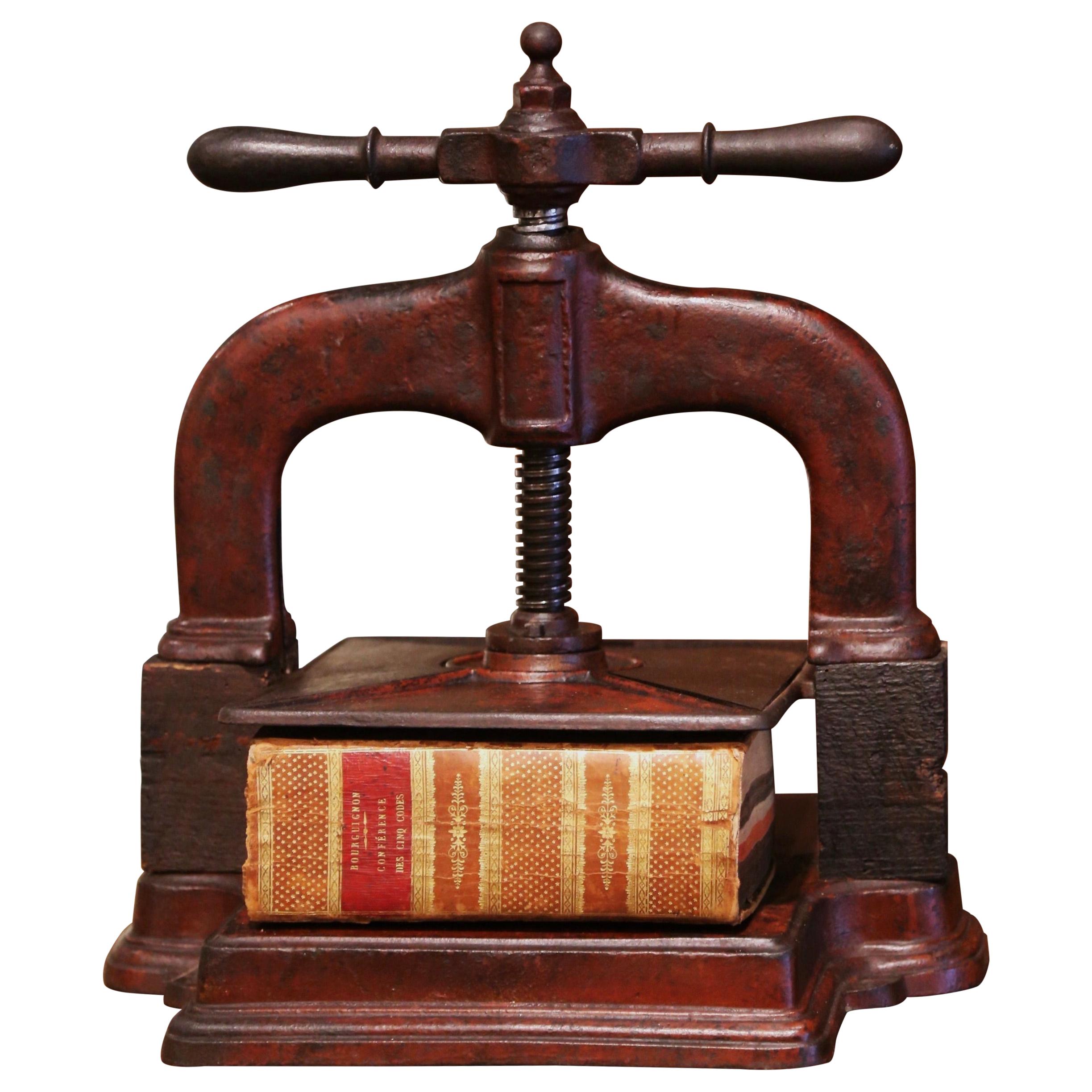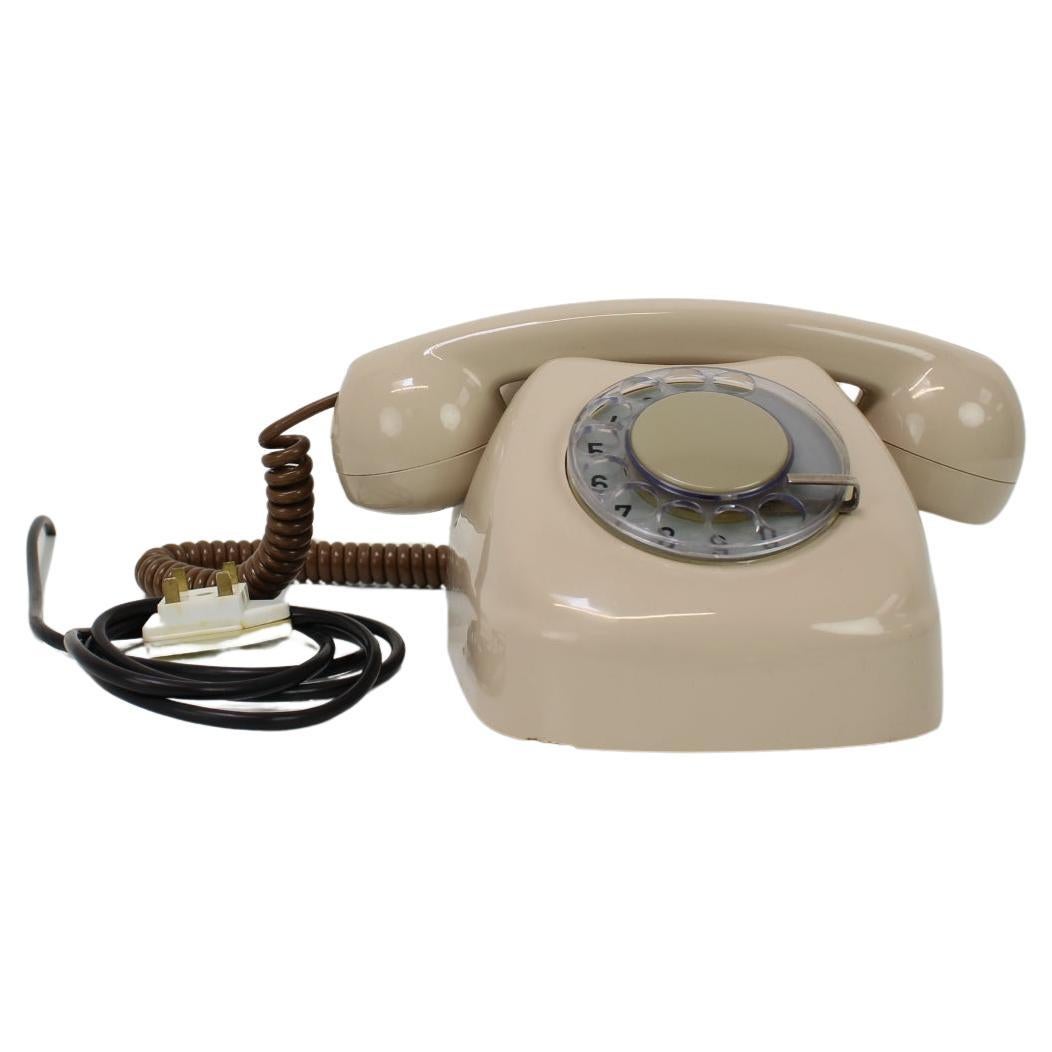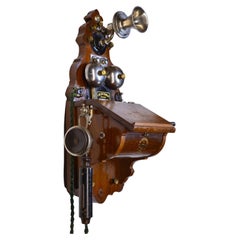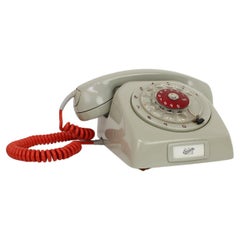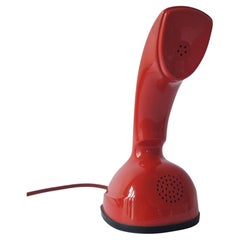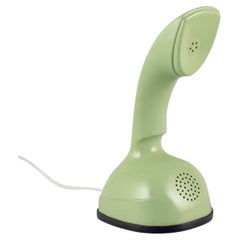Items Similar to L. M. Ericsson BC 2000 Telephone Made in 1900 Designed as Old Times Book Press
Want more images or videos?
Request additional images or videos from the seller
1 of 10
L. M. Ericsson BC 2000 Telephone Made in 1900 Designed as Old Times Book Press
About the Item
Very rare collectible desktop telephone L. M. Ericsson model BC 2000 (Old Catalogue No. 400) for battery ringing. Exclusive and unusual design in the form of an old times book press. Framework of polished walnut. Micro-telephone RE 2002 (Old Cat. No. 520) with cord RS 7021 (Old Cat. No. 2252) and switch in the handle resting on a cradle switch, flexible cable, RS 9000 (Old Cat. No. 2084) and terminal block within Ericssons serial number that dates device on 1900 Stockholm, Sweden.
Size app.: 22.5 cm (roughly 8.9 in) high, 27 cm (roughly 10.6 in) wide, 11 cm (roughly 4.3 in) deep. Very good condition, age and usage wear plus tiny losses. Please study high-res pictures for cosmetic condition! In person actual item may appear darker or brighter than in our pictures, strictly depending on sufficient light in your environment. Weight of app. 2 kg it is going to measure some 3 kg packed for shipment.
Lars Magnus Ericsson began his association with telephones in his youth as an instrument maker. He worked for a firm which made telegraph equipment for the Swedish government agency Telegrafverket. In 1876, aged 30, he started a telegraph repair shop with help from his friend Carl Johan Andersson. The shop was in central Stockholm (No. 15 on Drottninggatan, the principal shopping street) and repaired foreign-made telephones. In 1878 Ericsson began making and selling his own telephone equipment. His phones were not technically innovative, as most of the inventions had already been made in the US. In 1878, he made an agreement to supply telephones and switchboards to Sweden's first telecom operating company, Stockholms Allmänna Telefonaktiebolag. Also in 1878, local telephone importer Numa Peterson hired Ericsson to adjust some telephones from the Bell Telephone Company. This inspired him to buy a number of Siemens telephones and analyze the technology further. (Ericsson had a scholarship at Siemens a few years earlier.) Through his firm's repair work for Telegrafverket and Swedish Railways, he was familiar with Bell and Siemens Halske telephones. He improved these designs to produce a higher quality instrument. These were used by new telephone companies, such as Rikstelefon, to provide cheaper service than the Bell Group. He had no patent or royalty problems, as Bell had not patented their inventions in Scandinavia. His training as an instrument maker was reflected in the high standard of finish and the ornate design which made Ericsson phones of this period so attractive to collectors. At the end of the year he started to manufacture telephones of his own, much in the image of the Siemens telephones, and the first product was finished in 1879. With its reputation established, Ericsson became a major supplier of telephone equipment to Scandinavia. Because its factory could not keep up with demand, work such as joinery and metal-plating was contracted out. Much of its raw materials were imported, so in the following decades Ericsson bought into a number of firms to ensure supplies of essentials like brass, wire, ebonite and magnet steel. Much of the walnut used for cabinets was imported from the US. As Stockholm's telephone network expanded rapidly that year, the company reformed into a telephone manufacturing company. But when Bell bought the biggest telephone network in Stockholm, it only allowed its own telephones to be used with it. So Ericsson's equipment sold mainly to free telephone associations in the Swedish countryside and in the other Nordic countries. The high prices of Bell equipment and services led Henrik Tore Cedergren to form an independent telephone company in 1883 called Stockholms Allmänna Telefonaktiebolag. As Bell would not deliver equipment to competitors, he formed a pact with Ericsson, which was to supply the equipment for his new telephone network. In 1918 the companies were merged into Allmänna Telefonaktiebolaget L. M. Ericsson. In 1884, a multiple-switchboard manual telephone exchange was more or less copied from a design by C. E. Scribner at Western Electric. This was legal, as the device was not patented in Sweden, although in the US it held patent 529421 since 1879. A single switchboard could handle up to 10,000 lines. The following year, L. M. Ericsson and Cedergren toured the US, visiting several telephone exchange stations to gather "inspiration". They found that US engineers were well ahead in switchboard design but Ericsson telephones were as good as any available. In 1884, a technician named Anton Avén at Stockholms Allmänna Telefonaktiebolag had combined the earpiece and the mouthpiece of a (by then) standard telephone into a handset. It was used by operators in the exchanges that needed to have one hand free when talking to their customers. Ericsson picked up this invention and incorporated it into Ericsson products, beginning with a telephone named The Dachshund.
- Attributed to:L.M. Ericsson (Manufacturer)
- Dimensions:Height: 8.9 in (22.61 cm)Width: 10.6 in (26.93 cm)Depth: 4.3 in (10.93 cm)
- Style:Art Nouveau (Of the Period)
- Materials and Techniques:
- Period:
- Date of Manufacture:e.g. 1892-1899
- Condition:Wear consistent with age and use. Minor losses. Very good condition, age and usage wear plus tiny losses. Please study high-res pictures for cosmetic condition! I.
- Seller Location:Sweden, SE
- Reference Number:1stDibs: LU8776241850592
About the Seller
No Reviews Yet
Vetted Professional Seller
Every seller passes strict standards for authenticity and reliability
1stDibs seller since 2023
10 sales on 1stDibs
Typical response time: Several days
- ShippingRetrieving quote...Shipping from: Sweden, Sweden
- Return Policy
Authenticity Guarantee
In the unlikely event there’s an issue with an item’s authenticity, contact us within 1 year for a full refund. DetailsMoney-Back Guarantee
If your item is not as described, is damaged in transit, or does not arrive, contact us within 7 days for a full refund. Details24-Hour Cancellation
You have a 24-hour grace period in which to reconsider your purchase, with no questions asked.Vetted Professional Sellers
Our world-class sellers must adhere to strict standards for service and quality, maintaining the integrity of our listings.Price-Match Guarantee
If you find that a seller listed the same item for a lower price elsewhere, we’ll match it.Trusted Global Delivery
Our best-in-class carrier network provides specialized shipping options worldwide, including custom delivery.More From This Seller
View AllAntique extra bell for L.M. Ericsson telephone model RA 10/2 RA 10/2000
By L.M. Ericsson
Located in Sweden, SE
RING BELLS for alternating current, Telefon AB LM Ericsson, model RA 10/2-RA 10/2000, seen in the 1930 catalogue, 2 bells in nickel-plated brass, back piece in oak, lithographed iron...
Category
Early 20th Century Swedish Art Deco Decorative Art
Materials
Metal, Brass
Antique L. M. Ericsson AC110 Iron Skeleton Telephone Taxen Eiffel Dachshund #3
By L.M. Ericsson
Located in Sweden, SE
Desktop telephone model AC 110 (Old catalogue No. 375) made by L. M. Ericsson, Stockholm in period of 1895-1910. A legendary model that enjoys special attention from collectors.
Size app.: 30 cm (roughly 11.8 in) high, 27 cm (roughly 10.6 in) wide, 14 cm (roughly 5.5 in) deep. Quite good condition, age and usage wear, attritions, damages, losses of 2 feet out of 4, original finish! Please study high-res pictures for cosmetic condition! In person actual item may appear darker or brighter than in our pictures, strictly depending on sufficient light in your environment. Weight of app. 6 kg it is going to measure some 8 kg packed for shipment.
Lars Magnus Ericsson began his association with telephones in his youth as an instrument maker. He worked for a firm which made telegraph equipment for the Swedish government agency Telegrafverket. In 1876, aged 30, he started a telegraph repair shop with help from his friend Carl Johan Andersson. The shop was in central Stockholm (No. 15 on Drottninggatan, the principal shopping street) and repaired foreign-made telephones. In 1878 Ericsson began making and selling his own telephone equipment. His phones were not technically innovative, as most of the inventions had already been made in the US. In 1878, he made an agreement to supply telephones and switchboards to Sweden's first telecom operating company, Stockholms Allmänna Telefonaktiebolag. Also in 1878, local telephone importer Numa Peterson hired Ericsson to adjust some telephones from the Bell Telephone Company. This inspired him to buy a number of Siemens telephones...
Category
Antique Late 19th Century Art Nouveau Scientific Instruments
Materials
Metal, Brass, Bronze
Antique Wooden Ericsson MB 115 Crank Magneto Field Telephone 1895 С Mark 1
By L.M. Ericsson
Located in Sweden, SE
Rare, hard to find. Telephone “C” Mark 1 (Mk 1), designed by Ericsson’s of Stockholm, was the first portable military telephone. It was used in large numbers in the South African War of 1899-1902 by the Telegraph Battalion RE and became the standard field telephone...
Category
Antique Late 19th Century Swedish Art Nouveau Desks
Materials
Metal, Brass
Antique Swedish Wooden Wall Telephone L.M. Ericsson model 305 Crank Magneto 1918
By L.M. Ericsson
Located in Sweden, SE
Rather small size wall telephone model 305 with detached earpiece, made in 1918 by L.M. Ericsson & Co, Stockholm.
Size app.: 45 cm (roughly 17.7 in) high, 23 cm (roughly 9.1 in) wid...
Category
Early 20th Century Swedish Art Nouveau Decorative Art
Materials
Metal, Brass
Swedish Sewing Set of Scissors Folding Knife early 20th century Eskilstuna
By Eskilstuna Armaturer
Located in Sweden, SE
Made by famous Eskilstuna workshops of Emil Ohlson and Carl Walfrid Dahlgren. The set is decorated with decorative motifs in the form of cotton flowers and foliage, and is decorated ...
Category
Early 20th Century Swedish Art Nouveau Desk Sets
Materials
Gold Plate, Stainless Steel
Antique Marble Paperweight with Figural Bronze Bird of Prey 19th century
Located in Sweden, SE
Late 19th century nice quality bronze and dark green marble work. The finely detailed plumage of the bird with its fierce gaze demonstrates the handiwork of the craftsman. In a world...
Category
Antique Late 19th Century Empire Paperweights
Materials
Marble, Bronze
You May Also Like
Rare Functional Telephone LM Ericsson, 1960's, Czechoslovakia
By L.M. Ericsson
Located in Praha, CZ
Rare telephone, 1960's, CZS.
Fully functional.
Repolished, cleaned, in original condition with a few signs of use.
Made of plastic.
Category
Vintage 1960s Czech Mid-Century Modern Desk Sets
Materials
Bakelite
Ericofon Midcentury Plastic Cobra Telephone, L.M Ericsson, Sweden 1960s
By L.M. Ericsson
Located in Praha, CZ
- rare in red
- marked
- very good original condition
- space age style
Category
Vintage 1960s Swedish Mid-Century Modern Desk Sets
Materials
Plastic
White Bakelite PTT Telephone by Ericsson
By Ericsson
Located in Van Nuys, CA
Vintage white Swedish Bakelite rotary table phone by Ericsson, circa 1950.
Measures 6" H x 9" W x 7.5 " D.
Category
Vintage 1950s Swedish Mid-Century Modern More Desk Accessories
Materials
Bakelite
Ericsson Cobra / Ericofon, analog telephone in light green plastic. 1960s.
Located in Copenhagen, DK
Ericsson Cobra / Ericofon, analog telephone in light green plastic.
1960s.
In perfect condition.
Dimensions: H 21.0 cm x W 10.0 cm.
With extra long cord.
Category
Vintage 1960s Swedish Scandinavian Modern Desk Sets
Materials
Plastic
19th Century French Rust Red Painted Wrought Iron Book Binding Press with Book
Located in Dallas, TX
This antique paper binding press was forged in France, circa 1860. The Classic "Presse a Relier" made of solid iron is almost square in shape and features scrolled decor on the facad...
Category
Antique Mid-19th Century French Paperweights
Materials
Iron
Mid-Century Design Telephone by Tesla, 1979, Czechoslovakia
By Tesla
Located in Praha, CZ
Vintage telephone ,manufacterd by TESLA in 1979, made in Czechoslovakia.
Made of plastic and metal.
Repolished, cleaned, shows minor signs of use.
Fully functional.
Category
Vintage 1970s Czech Mid-Century Modern More Desk Accessories
Materials
Plastic
